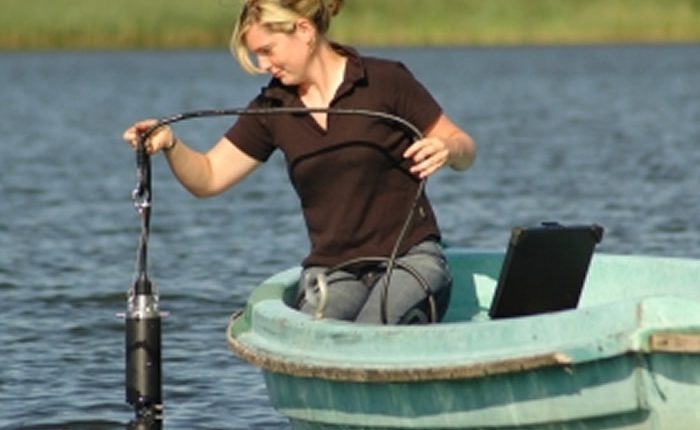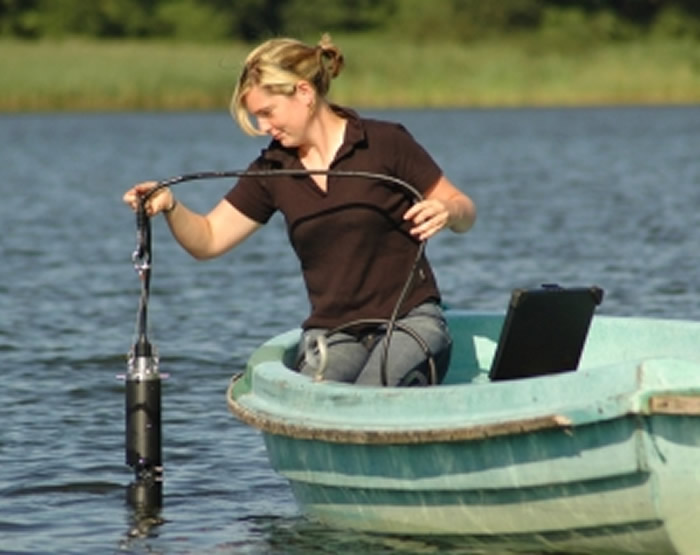All over the world, lakes, rivers, and coastal waters are threatened by high nutrient inputs. Nitrate or phosphates from waste-waters or fertilizers causes eutrophication. The consequence: Algae, in particular cyanobacteria (blue-green algae), grow uncontrollably and may release toxic substances.
Hence, extensive water monitoring is indispensable for drinking water supply and water protection. Researchers of Karlsruhe Institute of Technology (KIT) have now developed a smart monitoring system in cooperation with the companies ADM Elektronik and bbe Moldaenke. They combine various technologies in a depth profile-measuring multi-sensor buoy for monitoring water bodies and in particular algae growth. The project is funded by the Federal Ministry of Education and Research.
“A good water quality is of enormous importance to society. But high pollutant concentrations threaten drinking water resources, protection zones, or aquafarms worldwide. In particular blooms of cyanobacteria may release toxic substances that are hazardous for man and the ecosystem,” says Dr. Andreas Holbach, who coordinates the“WAQUAVID” cooperation project at KIT together with Professor Stefan Norra. Norra points out that conventional monitoring strategies are frequently based on a multitude of independently acting sensor systems. This aggravates and slows down integrated data evaluation. “We have to determine the state of the water body rapidly and holistically in order to be able to directly derive effective countermeasures,” Norra emphasizes.
WAQUAVID is aimed at developing an innovative multi-sensor depth profile-measuring buoy. Water bodies often are not homogeneously mixed, but have a depth-depending stratification of physical, chemical, and biological parameters. The new multi-sensor system will determine water quality at various depths. Based on this depth profile of water bodies, comprehensive analysis of the processes influencing water quality is possible. The buoy will be used to measure a number of parameters, such as temperature, oxygen concentration, algae content, and greenhouse gases, at the point of interest (in situ) as well as for remote water sampling. This measurement method is very precise, but locally limited. To study larger water areas, the researchers additionally use hyperspectral remote sensing data: Aircraft, such as drones, airplanes or satellites, record spectral data, e.g. characteristics of reflected radiation, of water, suspended particles, algae, and other substances with very high sensitivity. Using special evaluation algorithms, parameters can be derived to describe, together with the buoy data, the status of extended water surfaces with high spatial resolution. Hence, the hyperspectral camera represents the interface between local in-situ monitoring and large-area remote sensing of water bodies. KIT’s Environmental Mineralogy and Environmental Systems Analysis Group (ENMINSA) – a joint group of the Institute of Applied Geosciences and the Institute of Geography and Geoecology – and the Institute of Photogrammetry and Remote Sensing (IPF) cooperate with the companies ADM Elektronik (ADM) and bbe Moldaenke (bbe).
Power supply of the multi-sensor system takes place by wind power and solar cells. The measurement system is combined with CO2 and methane sensors, sampling and flow direction analysis systems, and a meteorological measurement station. In parallel, new methods are integrated into bbe’s “fluoroprobe” that measures the photosynthetic activity of various algae. Based on the measurement of phycocyanin, a pigment participating in photosynthesis, early warnings can be issued with respect to toxic substances from cyanobacteria. Moreover, scientists can use differentiated algae measurements to calibrate and validate remote sensing instruments for the measurement of water body area data.
In the future, it is planned to use the monitoring system in combination with remote sensing for water quality monitoring on the national, European, and international levels. It will be possible to analyse the ecological status of water bodies in situ and online. In this way, responsible authorities and companies will be enabled to make adequate and quick decisions for the protection of water quality and water ecosystems.
The cooperation project “Entwicklung einer Tiefenprofilmessboje zur in situ und online Multisensorüberwachung der Wasserqualität, Algenvitalität und –diversität (WAQUAVID)“ (Development of a Depth Profile-measuring Buoy for in-situ and online Multi-sensor Monitoring of Water Quality, Algae Vitality, and Diversity) is funded by the Federal Ministry of Education and Research (BMBF). It is part of the funding initiative “KMU-innovativ,” area “Sustainable Water Resources Management,” technology field “Resource Efficiency and Climate Protection.”
More information: Karlsruhe Institute of Technology



Comments are closed, but trackbacks and pingbacks are open.